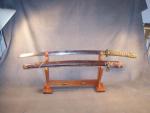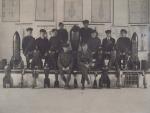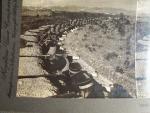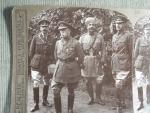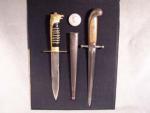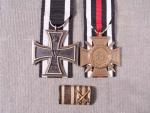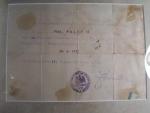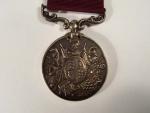-
Posts
6,486 -
Joined
-
Last visited
-
Days Won
10
Content Type
Profiles
Forums
Blogs
Gallery
Events
Store
Everything posted by Brian Wolfe
-
Hello All, I was digging through my stash of treasures and decided to share my modest collection of Japanese Swords with you. I was tempted to post this under the section dealing with Japanese Military History as the Japanese Sword is a history of Japan. Just a few notes on the Japanese Sword. Always store your sword in it's scabbard (Saya) and with the cutting edge UP! Never store the sword with the cutting edge down. There is a whole tradition on how to present and hold your sword both when showing it and when handing it over to another for inspection. Never, never, never ask to see another's sword blade. If it is not offered it is not polite to ask. Drawing the sword from its scabbard for inspection is also a delicate manuver. Don't draw it as if you are in a Samuri movie and don't pull it out inch by inch to "view" the blade, that is stuff for the movie camera as well (as in Kill Bill). Hold the scabbard in the left hand (blade edge up) and slowly draw the sword out trying not to let the blade touch the insides of the scabbard. Allow the blade to rest on it's back edge while drawing the blade out. When you get to the tip of the blade move the scabbard downwards so as to allow the blade to exit in a flowing manner. Another point on displaying your sword. In the average household you should see the sword in the rack with the handle to the viewer's left hand. You will notice that I have my swords to the right. This signified that the sword is in the home of a person who is ready to defend his hime and family against anything that may threaten the family. I have been schooled in the Toyama style of Japanese Swordsmanship of the All Japan Toyama Ryu Laido Kyokai. I take my swords very seriously, actually to the point of a religion ( I am also a Buddhist). End of sermon. The sword I am starting with is an NCO Shin-gunto c. 1945. These were made at the end of the war and material was not plentiful. I have started with this sword for two reasons. It represents the end of the long history of Japanese blades made for use in battle. The second reason is that as I post my collection I intend to save the oldest blades for last. The blade and tang of this sword are unmarked. Nakago (tang shape):Futsu Nakago-jiri (tang tip): Kuri-jiri Yasurime-mei (file marks): none Mekugi-ana (hole for handle peg): one Saya: Brown leather-covered wood SIngle ashi ( suspension ring) I hope you like my little collection. Cheers Brian
-
Hello Leigh, Under the magnifying glass the stripe really looks like a wound stripe to me. It looks to be one of the privately purchased brass stripes and not the sewen on cloth issue. I thought that there were some naval air service men in the photo as well but I am not familiar enough with uniforms to have made that claim in my original post. Since I purchased this photo I have been looking through several books written in the post war era and noticed several of the bombs, such as in my photo, shown being prepared for delivery to the air field. While my interest is mainly in medals I do find period photos and post cards very interesting. Cheers Brian
-
Hello All, At the moment I keep my collection in two closets measuring 9 feet in lenght and three feet in depth. In the one closet I have placed a drawer unit I built a number of years ago to store hand tools (I was a cabinet maker at that time). The drawers are lined with felt and I have not found that this has had any bad effects on my medals. I've used felt under my medals for many years. The drawers will hold two Riker Mounts each, one on top of the other, if I need the space. I've used the doors to hang more mounts and as the photo shows there are more Rikers stacked in the shelves. I decided that I would retire in 2006 and during this short period of time (I decided retirement was not for me and took another job) I started to make Riker-like mounts out of glass in our stained glass shop. Here's a tip. Don't go in that direction. The cost of material is about the same as a Riker and they weight a ton compaired to regular Rikers. Some day after I am "doing the dirt nap" someone will wonder why anyone would be crazy enough to make these cases out of glass. Actually the bottoms are plate glass so they are as strong as they are heavy, just don't drop one. I really liked the idea of the watch parts cabinet mentioned in an earlier posting. I think I will look into that. My wife has agreed that as soon as our daughter graduates university and she moves into her own place I can take over that room for the collection. Anyone know a good tutor? Cheers Brian
-
Hello All, Here is a photo of what I think is a group of RFC Training staff possibly from the bomber branch. The photo shows a nice variety of bombs and on the rear wall there are instructional charts showing the workings of the different bombs. I think the Sergeant Major sitting front left has a wound stripe on his left sleeve. Would anyone know if that is indeed what it is? On the back of the photo is the name "Eric Richardson" and a place name that I can not make out due to the person's hand writing. The name has two letters which looks like a "T" followed by a "u". The "T" looks to have not been crossed leaving it looking like a "spike" with the "u" attached. The rest of the name is clear enough and is "auston", followed by the date 1918. Anyone like to give the place name a go? I would think this photo was given out to the graduating classes. That is just a guess and not very worthy of an arm-chair historian I'm afraid. But I threw it out there anyway. I hope you like this picture, it's an interesting study. Cheers. Brian
-
Hello All, I just purchased a stereoscope card from an antigues mall taken during the Russo-Japanese War in 1904. The card's title is, " In the Trenches- Awaiting a Charge by the Enemy, Valley of the Shaho". From Wikipedia: The Battle of Shaho was a land battle of the Russo-Japanese War fought along a 37-mile front centered at the Sha River on the Mukden-Port Arthur spur of the China Far East Railway just north of Liaoyang, Manchuria. Check out Wikipedia for more details of this battle and the Russo-Japanese War in general. On the rear of the card is printed this observation, An American Missionary at Saga, Japan - Rev. H.V.S. Peeke - writes to friends in the United States: "I think you were a little surprised at the way Japan launched out with her navy and army. I cannot say that we residents were. We were not sure how far Russia's arrogance would carry her, but we knew that Japan was regarding this as a life and death question, and rather than take the slightest risk of falling into the purgatory in which Finland is suffering, she would pour out the last drop of blood and spend the last dollar of treasure. We knew too, that the Japanese army and navy were as good as money and discipline could make them. As to the outcome, prophesying is poor business, but I hope to see Japan push the Russians out of Korea and Manchuria, and take the Manchurian section of the railroad as pay for her pains. I think, too, that the powers will leave her alone if she avhieve this by force of arms. It must be remembered that with the powers that Japan has not a single broken promise to her discredit, while Russia has a long list." Japan certainly feels that she is resisting an oppressive, and rebuking a perfidious nation. God speed the Right. Well the old Rev. sure had an opinion. It is interesting how this struggle was to be a pattern for the First World War in many aspects. I hope you enjoy the photo and the thoughts of Rev. Peek. Cheers Brian
-
Hello All, A few years ago I discovered that sterioscope cards were an inexpensive source of period military photos. The Boer War, WW I and even the eariler Russo-Japanese War are well represented. Most people skulking about antiques shops and malls are not looking for military so there is quite often treasures to be found. "Skulking" is my wife's term for what I like to do on weekends. Anyway, I was hoping that some of the members might be able to help with the identification of the gentlemen in this photo. The title of this card is, "F.M. Sir John French, C-in-C in France, with A.D.C. at General Head Quarters". The card is not dated and the copyright date was smudged upon original printing. It would have to be early in the war as Sir John French was sacked in 1915 to be replaced by Sir Douglas Haig. I am especially interested in the gentleman in the turban. He wears a whistle on his "Sam Brown" and with my microscope I can read the King's cyper "GR" on his belt buckel. The writing above the cypher is too small to read even under the microscope. I would like to identify all of the men in this photo and I hope you might be able to help. Many thanks. Cheers Brian
-
That would be good return on the initial investment, let me think about it..... I think I'll pass, but you can send the bottle anyway. Cheers Brian
-
Hi Chris, Man, they would have loved you in post WW II Italy. My father traded one pack of smokes for the two daggers. His crew members laughed at him as they found out later such items were going for 3 smokes on average. Cheers Brian
-
Hello David, Very nice weapon. I've used one of these heavy rifles for hunting many years ago, not with the bayonet of course. If you lug one of these around through the bush for a couple of days you start to get an idea of how tough the WW I and WW II soldgiers must have been. I found myself considering attaching wheels to mine after about an hour! Cheers, Brian
-
Hello All, For the most part I don't like stories about how people's fathers or grandfathers came by their war souveniers. Especially when they are boiled down to, "He took it off a dead _____ (incert period racial slur here)". My late uncle who reluctantly when to war in 1944 and ended up seeing a lot of action that he never talked much about, used to tell us, "It's one thing to have to kill another man, it's another thing to scavenge his body for a trophy". He also said that most of those stories are a load of bull as when you are in battle the last thing you are thinking about is souveniers. I hope I did not insult anyone by saying this, it is just my opinion. Anyway, my father served in the Canadian Air Force, Bomber Command. At the end of the war after taking part in the last Canadian bomber mission of WW II on the island of Helgoland (it's off the coast of the Netherlands) his crew was given the duty of dumping tons and tons of unused bombs into the ocean. You can imagine how bored these young fellows must have been acting as flying dump trucks day after day after having flowen missions over Germany. They got the chance to fly Lancaster Bombers from England to Italy to bring back British soldiers so they jumped at opportunity. They flew the Halifax Bombers for most of the war so the chance to fly the Lancaster was icing on the cake. While on layover in Italy my father purchased the two daggers I am posting today. The one with the eagle pommel is the Air Force dagger and the other is the Italian Fascist MVSN (Militizia Voluntaria Sicurezza Nationale) poniard, Model 1925. According to the book, "Fighting Knives" by Frederick J. Stephens, the blade was probably made from the obsolescent bayonet blades of the Model 1897 Vetterli-Vitali. The blade was shortened and the steel hilt was inset with wood grips. This specimen has the brass fascist device inlaid into the wood grip. I added the Itialian "tinnie" to the display. There is a sword with the same eagle grip but I have not been able to add one to my collection. I am afraid that the price would probably cost a lot of cash and my marrige. Don't laugh I've made that choice before; you'll notice I still have the collection! Now for the big question. How much do you think my father paid for these daggers when he was in Italy in 1945/46? Remembering that it was a barter economy at the time. Cheers Brian
-
Hi Tom, Several countries used a very similar bayonet. There is an Austrian Model 1854 at 560.5 mm, one from the Netherlands Model 1871, First Pattern at 583 mm and a Second pattern at 579 mm. Yours, according to your measurement is 555.5 mm. Given a measure of error lets say 550mm. This lenght and the markings that show on the photograph match the Swiss Bajonett Ordonnanz 1863 in Paul Kiesling's book, "Bayonets of the World", Volume Two # 315 on page 20. Just in case you don't have this book here are the rifles and some background history from his book. Rifles: Infanteriegewehr Ordonnanz 1863 " " 1843 abgeandert 1867 Gewehr system Peabody Ordonnanz 1867 " " " " 1867/77 Repetier-Infanterie-Gewehr system Vetterli Ordonnanz 1869/71 Vetterli Ordonnanz 1871. Background: In 1867 Switzerland purchased 15,000 Peabody rifles from the U.S.A. They were manufactured by the Providence Tool Company. At first the rifle was issued to sharpshooters only, but later on also to the sappers and miners. Used 1863-1878 I hope that is a little help. Cheers Brian
-
I think you are correct on the jewellery suggestion. I have used black light with no luck. I've also use several different magniying loops and even my microscope. I looks like a buffing wheel was used so the finished job, though incomplete, looks better than the old bastard file job(type of file not a file born out of wedlock). Cheers Brian
-
Oh, I think I will stop where I am with this medal. The small triangle that I secured was in danger of falling out. It was a matter of fix it or risk the piece getting lost. Cheers Brian
-
Gentlemen, Here is a photo of the EK II that I rehabilitated (and posted earlier today) along with a Hindenburg Cross and a ribbon bar from that period. I don't have a lot of knowledge of Imperial German medals so I hope the term Hindenburg Cross is correct. Both came without ribbons so I have "mounted" them in a rather "British" fashon as I do not know how to imitate the German style. If there is a web site that would give me intstructions on the corect way to mount German medals please let me know and I will remount them. I have included a ribbon bar that I think would be correct for that period. It has seen better days but then so have I. Cheers Brian
-
Hello Gentlemen, I have just finished rehabilitating a WW I EK II that came to my collection in damaged condition. When I got this Iron Cross it was missing the ribbon and ribbon ring and there was a "V" shaped crack bteween the "W" and "1914. The "V" was horizontal pointing to the viewer's right. Since the black iron portion was separate of the outer boarder I could move the two larger parts away from each other and leave a "V" shaped space around the smaller piece. I took a very small drop of epoxy on a fine needle and put one drop in the crack on both sides of the "V". after this set the broken piece was secure. I then took black boot polish, the wax type, and rubbed it into the crack and surrounding area. The result was better than I had hoped. I tried to photograph it so you could see the repair but it is difficult to make out. It shows up better on the reverse as the crack went through the oak leaves' stem. I then manufactured a new ring from steel wire using a correct sized mandrel. There was no need to solder the ring as it was to be coverd by the ribbon. Please excuse the mounting, I know it is incorrect, I just liked it this way. I quite often give a home to an item that has seen better days as they are pieces that should be preserved. I think that any repair should be reversable if at some time another collector wishes to return it to "as found condition" and I don't think you should repaire anything to the point that it could pass as undamaged. I hope you like my rehabilitated EK II. Cheers Brian
-

EK 1914 My EK II Document
Brian Wolfe replied to Brian Wolfe's topic in Germany: All Eras: The Iron Cross
Hi Rick, I didn't know there was even a chance of researching this fellow. I wish I had more information. Cheers Brian -
Hello All, I am posting a photo of an EK II document from my collection. It is not all that great or showy but I purchased it because of the name. Our family originated in Germany and over the course of many years (going back hundreds of years) migrated back and forth between Germany and the UK. Somewhere along the way we changed the spelling of our name from Wolff to Wolfe. Most of the Wolfe side of the family was involved in the British military. The Wolff "group" settled in and around Belfast. This EK II was awarded to Fusl. Wolff. Not very likely a true relation but I liked it and now it lives with the rest of the collection. The document says (pardon my poor German translation), Identification Card, In the name of His Majesty the Emperor and King is the Fusilier Wolff second order the 12th Company Fusilier Regiment Prince Karl Anton von Hohenzollern (Honzollernsches) Unit number 40 on 18. 4. 1917 the Iron Cross II. Class is conferred and has been declared. I have not been able to gain any knowledge on this unit or where they were on or around that date. I hope you like it. Cheers Brian
-
Hi Ralph, Wow! That's a great collection. Thanks for sharing. Cheers Brian
-
Hello fellow members, Here is a LSGC medal that I picked up several years ago. From the two holes near the hanger it would look as if this has not always been with the present hanger. The hanger looks correct but the two hole are one of the mysteries of this medal. The swivel attachment of this piece has been replaced by a small bolt! The recipient's name has been polished off, or nearly so. what I can make out is the following, "408 Qt. Mr.Sergeant,(area where the name would have been), N. Staff. R. (North Staffordshire Reg.?) Why anyone would only partially remove the lettering is a mystery to me. I was able to pick this one up at a pretty good price as the name had been removed. Still it is to a Quarter Master Sergeant and perhaps some day I will be able to trace the original owner through his number and regiment and it is in pretty good condition. The reverse is the usual, "For Long Service and Good Conduct". Cheers Brian




